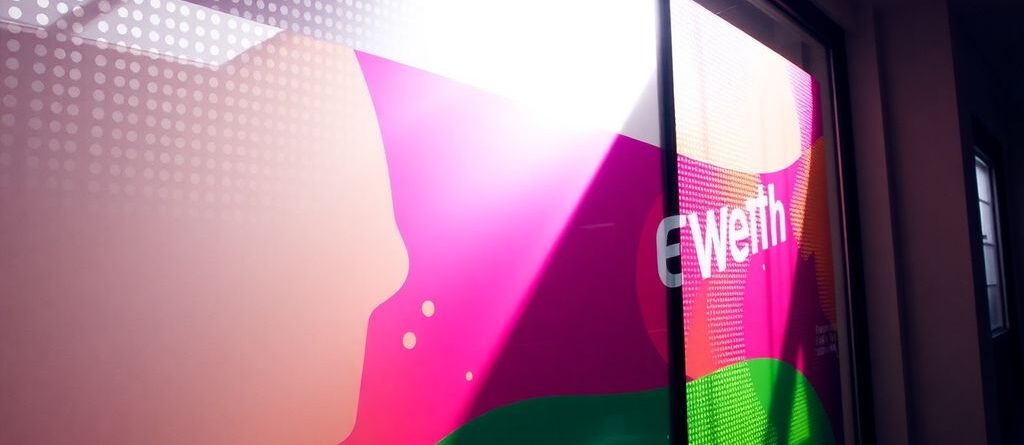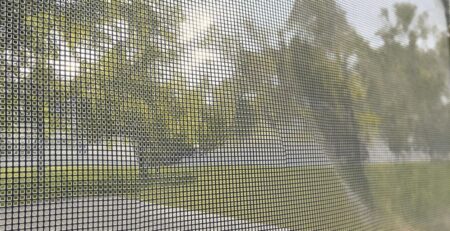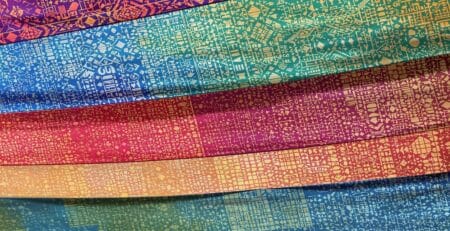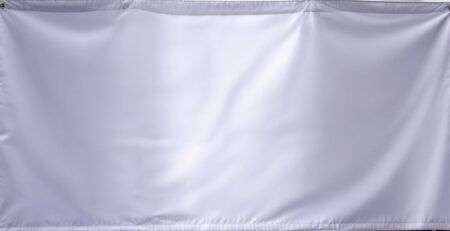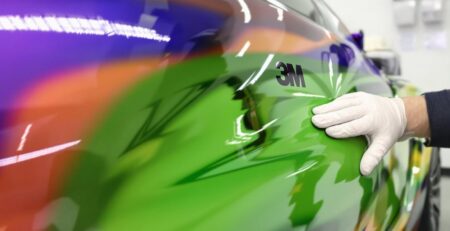Transform Your Space with Perforated Window Vinyl: A Guide to One-Way Vision Signage
If you’re looking to spruce up your space while adding a touch of privacy, perforated window vinyl might just be the answer. This versatile material not only transforms the look of your windows but also serves practical purposes like advertising and light control. In this guide, we’ll walk you through everything you need to know about using perforated window vinyl, from installation to design tips and maintenance.
Key Takeaways
- Perforated window vinyl allows visibility from the inside while obscuring views from the outside.
- It’s great for advertising and can enhance privacy in commercial spaces.
- Installation requires a clean surface and careful application to avoid bubbles.
- Designing effective graphics involves using bold colors and considering negative space.
- Regular maintenance can extend the life of your perforated vinyl and keep it looking fresh.
Understanding Perforated Window Vinyl
What Is Perforated Window Vinyl?
Okay, so what is this stuff? Perforated window vinyl, also known as one-way vision film, is a special kind of material that lets you put a graphic on your window while still being able to see out. It’s basically a sticker with tiny holes all over it. From the outside, you see the image, but from the inside, you see through the holes like a tinted window. It’s pretty cool, and it’s used a lot for advertising and privacy.
Benefits of Using Perforated Window Vinyl
Why would you even bother with this stuff? Well, there are a bunch of reasons:
- Advertising: You can turn your windows into advertising space without blocking the view from inside. Think about it – prime real estate just sitting there!
- Privacy: It adds a layer of privacy because people outside can’t easily see in during the day. It’s like having a built-in blind, but way more stylish.
- Sun Control: It can reduce glare and heat from the sun, making your space more comfortable. This is especially nice in the summer.
- Aesthetics: You can use it to add some visual interest to your building or vehicle. Plain windows are boring, right?
I remember when a local coffee shop put up some perforated vinyl with their logo and a picture of a latte. It looked amazing, and I actually went in because of it. It’s a simple way to make a big impact.
Common Applications for Perforated Window Vinyl
Where do you usually see this stuff? Everywhere, once you start looking! Here are some common places:
- Storefronts: Businesses use it to advertise sales, products, or just their brand. It’s a great way to attract attention.
- Vehicle Windows: You see it on buses, vans, and even some cars. It’s a mobile billboard!
- Office Buildings: It can add privacy and a professional look to office windows. No one wants to feel like they’re in a fishbowl.
- Residential Use: Some people use it on their home windows for privacy or decoration. Why not, right?
And if you’re thinking about getting some, remember to check out window decals for your business. They’re a great way to advertise!
Installation Process for Perforated Window Vinyl

Preparing the Surface for Installation
Before you even think about slapping that perforated vinyl on your window, prep is key. I mean, seriously, don’t skip this step. You’ll regret it. Think of it like painting – you wouldn’t paint over a dirty wall, right? Same principle here. Start by giving the window a good scrub. Warm, soapy water is your friend. Get rid of all the dirt, dust, grime, and any other gunk that’s accumulated. After washing, make sure to dry the surface completely. Any moisture left behind can mess with the adhesive and cause bubbles or peeling. And nobody wants that.
- Clean the window with warm, soapy water.
- Remove any residue with a glass cleaner.
- Thoroughly dry the surface before application.
A clean, dry surface is the foundation for a successful vinyl installation. Taking the time to properly prepare the window will significantly improve the adhesion and longevity of your perforated vinyl.
Step-by-Step Installation Guide
Okay, now for the fun part – actually putting the vinyl on! It might seem intimidating, but trust me, it’s doable. First, peel back a small portion of the backing from the vinyl, maybe just a few inches. Position the exposed adhesive side onto the top of the window where you want to start. Use a squeegee (or even a credit card in a pinch) to smooth the vinyl down as you slowly peel away the rest of the backing. Work from the center outwards to avoid trapping air bubbles. If you do get bubbles, don’t panic! You can usually smooth them out with the squeegee. If they’re stubborn, a tiny pinprick can release the air. Once the entire vinyl is applied, go over it again with the squeegee, applying firm pressure to ensure good adhesion. Finally, trim any excess vinyl around the edges with a sharp blade for a clean, professional look.
Tips for a Smooth Application
Alright, here are some extra tips to help you nail that window film installation like a pro:
- Work in a well-lit area. This makes it easier to spot bubbles and imperfections.
- Use a spray bottle with a mixture of water and a drop of dish soap. Lightly misting the window can help you reposition the vinyl if needed.
- If you’re working with a large piece of vinyl, ask a friend for help. It’s much easier to manage with two people.
| Problem | Solution |
|---|---|
| Air bubbles | Use a squeegee to smooth them out. Prick with a pin if needed. |
| Vinyl not sticking | Ensure the surface is clean and dry. Apply more pressure. |
| Wrinkles | Gently peel back the vinyl and reapply, smoothing as you go. |
Designing Effective Graphics for Window Vinyl
Choosing the Right Colors and Fonts
Okay, so you’re ready to design some graphics for your perforated window vinyl? Awesome! First things first: colors and fonts. This isn’t just about what looks good, but what works well with the material. Remember, perforated vinyl isn’t a solid surface, so your design needs to account for those little holes. High-contrast colors are your friend. Think bold and bright to really grab attention. Subtle shades can get lost in the mix.
When it comes to fonts, legibility is key. A fancy script might look cool on your computer screen, but if people can’t read it from a distance, what’s the point? Go for clean, clear fonts that are easy to read, even with the perforations. Consider the overall tone you’re going for – professional, playful, modern – and choose fonts that match. You can use vinyl lettering to make your message stand out.
Incorporating Branding Elements
This is where you make it you. Slapping your logo on the window is a start, but think bigger. How can you weave your brand’s personality into the design? Use your brand colors, of course, but also think about patterns, shapes, and imagery that are associated with your company.
- Make sure your logo is clear and recognizable, even at a distance.
- Use consistent branding elements across all your window graphics.
- Consider incorporating your slogan or a short, catchy tagline.
Don’t be afraid to get creative! Window vinyl is a great way to showcase your brand’s unique identity. Just remember to keep it consistent with your other marketing materials.
Utilizing Negative Space in Designs
Negative space, or "white space," is the empty area around and between the elements of your design. It’s not just wasted space – it’s a powerful tool for creating balance and visual appeal. In fact, it can be used to create branded company vehicle designs. With perforated window vinyl, negative space is even more important because it allows light to pass through, maintaining visibility from the inside.
Here’s why negative space matters:
- It makes your design easier to read and understand.
- It creates a sense of balance and harmony.
- It helps to highlight the important elements of your design.
Think of it like this: a cluttered window is a confusing window. By using negative space effectively, you can create a design that’s both eye-catching and functional.
Maintenance and Care for Perforated Window Vinyl
Cleaning Techniques for Longevity
Keeping your perforated window decals clean is super important to make them last. I usually just use a soft, damp cloth with some mild soap. Avoid anything abrasive, because that can scratch the surface and ruin the image.
Here’s a quick rundown:
- Use a soft cloth or sponge.
- Mix mild soap with water.
- Gently wipe the surface.
- Rinse with clean water.
- Let it air dry.
I’ve found that regular cleaning, like once a month, really helps prevent dirt buildup. It’s a small thing that makes a big difference in how long the vinyl looks good.
Signs of Wear and When to Replace
Even with the best care, perforated window vinyl won’t last forever. Keep an eye out for these signs that it might be time for a replacement:
- Fading colors: If the image starts to look dull, the UV protection might be wearing off.
- Peeling edges: This can happen due to weather or improper installation.
- Cracking or tearing: This is a sign of significant wear and tear.
- Reduced visibility: If the holes get clogged with dirt, it can affect the one-way vision.
If you notice any of these, it’s probably time to think about getting new window vinyl.
Protecting Your Vinyl from the Elements
To extend the life of your perforated window vinyl, consider these tips:
- Apply a UV-protective coating: This can help prevent fading from sunlight.
- Avoid harsh chemicals: When cleaning, stick to mild soap and water.
- Consider lamination: Lamination adds an extra layer of protection against scratches and weather.
- Park in the shade: If it’s on a vehicle, parking in the shade can reduce sun exposure.
Here’s a simple table showing the impact of lamination:
| Feature | Without Lamination | With Lamination |
|---|---|---|
| Lifespan | ~1 year | ~2 years |
| Scratch Resistance | Low | High |
| UV Protection | Moderate | Enhanced |
Comparing Perforated Window Vinyl to Other Signage Options
Vinyl Window Decals vs. Perforated Vinyl
Okay, so you’re trying to figure out the best way to get your message on a window. Let’s break down vinyl window decals and perforated vinyl. Vinyl decals are like stickers – full color, adhesive on the back, and they stick directly to the glass. They’re great for storefronts because they grab attention. You can get them in all sorts of shapes and sizes, even intricate lettering. Plus, they can offer some privacy without completely blocking the view. We print our vinyl window decals on high-quality vinyl with UV inks, so the colors really pop. They can last up to 6 years with lamination, which is pretty good.
Perforated vinyl, on the other hand, has tiny holes all over it. This is what gives it that one-way vision effect. From the outside, you see the graphic, but from the inside, you can still see out. This makes it super popular for vehicles. You could cover all your car windows and still be able to drive safely. It also acts as a bit of window tinting, keeping things cooler inside. We use a specific perforation ratio that balances visibility and how vibrant the graphic looks. Perforated vinyl lasts around 2 years with lamination.
Static Cling Stickers: Pros and Cons
Static cling stickers are those thin plastic sheets that stick to glass without any adhesive. Remember those? They’re super easy to remove and reapply, which is a big plus. You often see them used for temporary promotions or decorations. But, they’re not as durable as vinyl decals or perforated vinyl. They’re also usually translucent, so they don’t offer the same level of opacity or color vibrancy. Think of them as the less permanent, more flexible option. They’re great for short-term needs, but not ideal if you want something that will last for years.
Here’s a quick rundown:
- Pros: Easy to apply and remove, reusable, no adhesive residue.
- Cons: Less durable, not as vibrant, limited opacity.
- Best for: Temporary promotions, seasonal decorations, short-term signage.
Frosted Glass Film: When to Use It
Frosted glass film is a whole different ballgame. It’s designed to mimic the look of etched or sandblasted glass. It doesn’t have any graphics printed on it; it just provides privacy by blurring the view. You’ll often see it used in offices or bathrooms where you want to let light in but block visibility. It’s a more subtle and sophisticated option than decals or perforated vinyl. It’s not really for advertising or displaying graphics, but it’s perfect for creating a sense of privacy and elegance. If you’re looking for something purely decorative or functional, frosted glass film might be the way to go.
Frosted film is great for situations where you want to obscure the view without blocking light. It’s a good choice for office spaces, bathrooms, or any area where privacy is a concern. It’s also a relatively inexpensive way to add a touch of elegance to your space.
Enhancing Privacy and Aesthetics with Window Vinyl
Creating Privacy in Commercial Spaces
Perforated window vinyl is a game-changer for businesses needing privacy without sacrificing natural light. Think about it: customers inside want to feel comfortable, and employees need to focus. One-way vision vinyl lets you achieve this by blocking the view from the outside while maintaining visibility from within. It’s like a secret shield that doesn’t make the place feel closed off. You can even use advertising flags to attract more customers.
Using Vinyl for Decorative Purposes
Window vinyl isn’t just about function; it’s a fantastic way to add some flair. You can use it to display your company logo, create eye-catching designs, or even mimic the look of etched glass. It’s a simple and cost-effective way to transform a plain window into a work of art. Plus, it’s easy to change out the designs as needed, keeping your space fresh and up-to-date. Here are some ideas:
- Seasonal decorations
- Promotional graphics
- Abstract art patterns
Balancing Light and Privacy Needs
Finding the right balance between light and privacy can be tricky. Opaque vinyl window decals offer maximum privacy but block the most light. Perforated vinyl is a great middle ground, allowing some light to filter through while still providing a decent level of privacy. Frosted vinyl is another option, diffusing light and obscuring the view without completely blocking it. The best choice depends on your specific needs and the amount of natural light you want to let in.
Choosing the right window vinyl involves considering several factors, including your intended purpose, design preferences, and the characteristics of your space. Understanding your primary goal will guide your decision-making process and ensure that you select window decals that align with your objectives.
Cost Considerations for Perforated Window Vinyl

Budgeting for Materials and Installation
Okay, so you’re thinking about getting some perforated window vinyl? Great choice! But let’s talk money. The cost can vary quite a bit depending on a few things. First, there’s the vinyl itself. Higher quality perforated window film will cost more, but it’ll also last longer and look better. Then you’ve got the size of the area you’re covering – obviously, a huge storefront is going to cost more than a small office window. And don’t forget about installation! If you’re not the DIY type, you’ll need to factor in the cost of professional installation.
Here’s a rough breakdown of what you might expect to pay:
- Materials: $3-$8 per square foot (depending on quality)
- Installation: $2-$5 per square foot (if you hire a pro)
- Design: $50-$500 (depending on complexity; could be free if you design it yourself)
Keep in mind these are just estimates. Get quotes from a few different suppliers and installers to get a better idea of the actual cost for your project.
Long-Term Value of Window Vinyl
Okay, so the initial cost might seem a little high, but think about the long game. Perforated window vinyl can actually save you money in the long run. How? Well, for starters, it can act as a sun shade, reducing your energy bills by keeping your space cooler. Plus, it’s a great way to advertise your business or promote special offers without having to pay for expensive billboards or other advertising. And let’s not forget about privacy – window vinyl can help keep prying eyes out, which can be a real asset for offices or retail spaces.
Think of it as an investment, not just an expense. Good quality vinyl, properly installed, can last for years, providing advertising, privacy, and energy savings all in one go. It’s a pretty cost-effective solution when you look at the big picture.
Comparing Costs with Other Signage Solutions
So, how does perforated window vinyl stack up against other signage options in terms of cost? Let’s take a look:
- Vinyl Window Decals: Generally cheaper upfront, but may not offer the same level of privacy or sun protection. Plus, they might not last as long.
- Static Cling Stickers: A budget-friendly option for temporary promotions, but they’re not as durable and don’t offer the same visual impact. They are easy to remove and reapply.
- Frosted Glass Film: A more permanent solution for privacy, but it doesn’t offer any advertising opportunities and can be more expensive to install.
Here’s a quick comparison table:
| Signage Type | Upfront Cost | Durability | Privacy | Advertising | Other Benefits |
|---|---|---|---|---|---|
| Perforated Window Vinyl | Moderate | Good | Yes | Yes | Sun protection |
| Vinyl Window Decals | Low | Fair | No | Yes | Simple to install |
| Static Cling Stickers | Very Low | Poor | No | Yes | Temporary, reusable |
| Frosted Glass Film | High | Excellent | Yes | No | Permanent, elegant look |
Ultimately, the best option for you will depend on your specific needs and budget. But hopefully, this gives you a better idea of the cost considerations involved with perforated window vinyl.
When thinking about the costs of perforated window vinyl, it’s important to consider several factors. First, the size of the windows and the amount of vinyl needed will affect the price. Additionally, the quality of the vinyl can vary, which may influence how long it lasts and how it looks. Don’t forget to factor in installation costs, too. If you want to learn more about how to choose the right vinyl for your needs, visit our website for helpful tips!
Wrapping It Up
In conclusion, using perforated window vinyl can really change how your space looks and feels. It’s not just about making a statement; it’s also practical. You get to enjoy your view while keeping prying eyes out. Plus, it’s a great way to advertise without sacrificing privacy. Whether you’re looking to spruce up your office, store, or vehicle, this type of signage offers a lot of benefits. So, if you’re ready to transform your windows into something special, give one-way vision vinyl a shot. You might be surprised at how much of a difference it can make!
Frequently Asked Questions
What is perforated window vinyl?
Perforated window vinyl is a special type of film that has tiny holes in it. This allows people inside a building to see out, while making it hard for people outside to see in. It’s great for advertising and privacy.
Where can I use perforated window vinyl?
You can put perforated window vinyl on any window, whether it’s in a store, office, or even on cars. It’s perfect for places where you want some privacy but still want to see outside.
How do I install perforated window vinyl?
To install it, first clean the window well. Then, wet the window surface, peel off the backing of the vinyl, and place it on the wet window. Use a squeegee to remove bubbles and let it dry for a day.
How long does perforated window vinyl last?
With proper care, perforated window vinyl can last about 1 to 2 years, depending on the conditions and if it has a protective layer.
Can I design my own graphics for window vinyl?
Yes! You can create your own designs. It’s best to use bold colors and clear fonts to make sure your message stands out.
Is perforated window vinyl easy to remove?
Yes, perforated window vinyl is easy to take off. You can peel it away without damaging the window, making it a good choice for temporary advertising.

